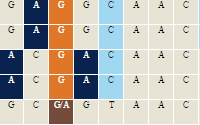FACL4, encoding fatty acid-CoA ligase 4, is mutated in nonspecific X-linked mental retardation. |
| Authors: |
Meloni, I Muscettola, M Raynaud, M Longo, I Bruttini, M Moizard, MP Gomot, M Chelly, J Des Portes, V Fryns, JP Ropers, HH Magi, B Bellan, C Volpi, N Yntema, HG Lewis, SE Schaffer, JE Renieri, A
|
| Citation: |
Meloni I, etal., Nat Genet 2002 Apr;30(4):436-40. |
| RGD ID: |
1300358 |
| Pubmed: |
PMID:11889465 (View Abstract at PubMed) |
| DOI: |
DOI:10.1038/ng857 (Journal Full-text) |
X-linked mental retardation (XLMR) is an inherited condition that causes failure to develop cognitive abilities, owing to mutations in a gene on the X chromosome. The latest XLMR update lists up to 136 conditions leading to 'syndromic', or 'specific', mental retardation (MRXS) and 66 entries leading to 'nonspecific' mental retardation (MRX). For 9 of the 66 MRX entries, the causative gene has been identified. Our recent discovery of the contiguous gene deletion syndrome ATS-MR (previously known as Alport syndrome, mental retardation, midface hypoplasia, elliptocytosis, OMIM #300194), characterized by Alport syndrome (ATS) and mental retardation (MR), indicated Xq22.3 as a region containing one mental retardation gene. Comparing the extent of deletion between individuals with ATS-MR and individuals with ATS alone allowed us to define a critical region for mental retardation of approximately 380 kb, containing four genes. Here we report the identification of two point mutations, one missense and one splice-site change, in the gene FACL4 in two families with nonspecific mental retardation. Analysis of enzymatic activity in lymphoblastoid cell lines from affected individuals of both families revealed low levels compared with normal cells, indicating that both mutations are null mutations. All carrier females with either point mutations or genomic deletions in FACL4 showed a completely skewed X-inactivation, suggesting that the gene influences survival advantage. FACL4 is the first gene shown to be involved in nonspecific mental retardation and fatty-acid metabolism.
|
|




















